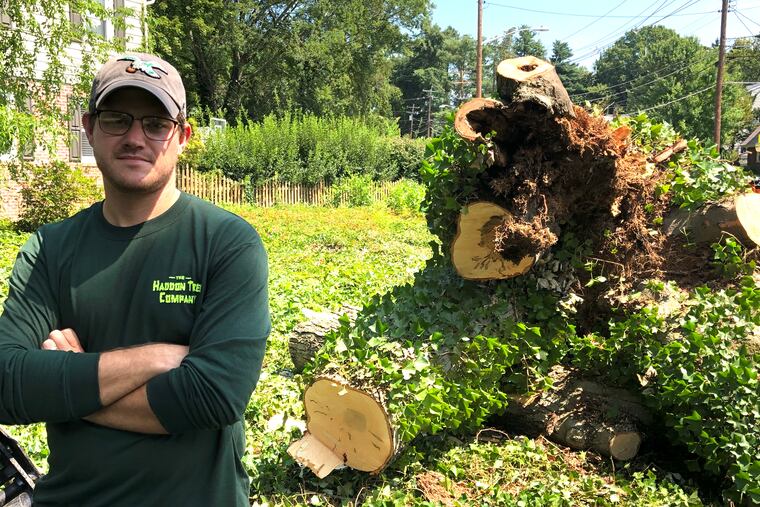This has been a tough season so far for trees | Kevin Riordan
Arborists and others agree: We're losing a lot of big old trees this summer.

The massive trunk of a red maple that had towered over the corner of Second and Highland Avenues for nearly a century crashed to earth last week with a dust-raising thump.
It was just another hot summer morning of work for a five-member Haddon Tree Co. crew in Haddon Heights — and another new gap in a tree canopy that creates cooling shade, curb appeal, and community pride in the borough and many other South Jersey communities.
“We’re losing a lot of trees,” said foreman Brian Rattay, who has overseen the removal of 50 or so specimens felled or gravely wounded during a brief but destructive July 22 storm.
"It took a particularly significant toll,” Rattay, a certified arborist, said. “The Erlton South section of Cherry Hill looked like a war zone.”
Extreme weather is not the sole reason for the relentless, and, in places, dramatic loss of trees in suburban and urban neighborhoods in Camden County, elsewhere in South Jersey, and across the Philadelphia region. And tree loss has an impact not only on aesthetics, but on ecosystems and public safety: Falling limbs can injure or kill, as well as take down utility lines and damage buildings or vehicles.
The trees that have long defined many streetscapes in Haddonfield, Collingswood, Cherry Hill, and other communities are under stress from age, disease, pests — particularly the emerald ash borer and spotted lanternfly — and human activities. Aggressive pruning by utilities such as PSEG also can contribute to a patchy look.
“There may be data to support the fact that there are more intense storms happening more frequently, so it is important that municipalities and counties have a local urban and community forestry program to ensure that the local resource is resilient and can recover,” said Caryn Shinske, a public information officer for the New Jersey Department of Environmental Protection.
“There’s more development, more people, and more utilities, and the utilities are being more forceful in pruning to keep trees away from their lines,” said Haddon Heights arborist Steve Dorsey, who’s been in the tree business for nearly 50 years. He doesn’t believe there are any other new or unusual stresses on the canopy.
“People pave around trees, plant grass around them, prune them wrong, and use weedkillers and chemicals that [harm] them,” Dorsey said. Ground saturated by abundant rainfall like this summer’s can make curbside trees with compromised root systems especially vulnerable to strong winds, he added.
“Our canopy is definitely threatened as the weather becomes more violent and utilities are allowed to butcher trees, sometimes with impunity,” said John Gibson, chairman of the Moorestown Planting and Tree Preservation Committee.
I too have noticed some rather creatively pruned trees in proximity to power lines in South Jersey, and have been struck by how odd and even downright skeletal some look.
PSEG has a different view.
“While we have a responsibility to deliver safe and reliable electricity … we are also environmental stewards who work to preserve the canopy and health of trees wherever possible,” Robert Wolf, a PSEG vegetation manager, said in a statement. “The absolute best way for trees and wires to coexist is to select the right tree to plant in the right place, which can minimize or even eliminate pruning.”
Said Lauren Ugorji, a PSEG spokesperson: “One of the challenges is, the state is old and our power system is more than a century old as well, and [some] municipalities made decisions based on beautification rather than coexistence. As trees come down, there’s no reason they can’t be replaced with beautiful trees that only go so high, and still provide the canopy, but can coexist with power lines."
Gibson and Dorsey acknowledge that some trees simply have been planted in the wrong places. Likewise, the once-common practice of planting expanses of trees of a single species can make an area vulnerable to a complete wipeout, as happened to elm trees in the 1960s and is happening now to ash trees.
“We’ve had ‘right tree in the right place’ seminars, and we try to be very vigilant about what gets planted where,” Gibson said. “I love big, tall trees. But big, tall trees don’t work under power lines — although the ones that weren’t the right thing to plant sure look nice.”
They do. And we ought to admire them while they last.
Some enormous and beloved South Jersey trees have fallen in recent months, among them the Salem Oak, which had been growing in what is now a Quaker cemetery in the city of Salem for 565 years, and a 128-year-old oak in front of the United Methodist Home Community in Collingswood.
Fortunately, a majestic 226-year-old American elm on the White Horse Pike in Audubon — it may well be the tallest tree in New Jersey — appears to be doing just fine.